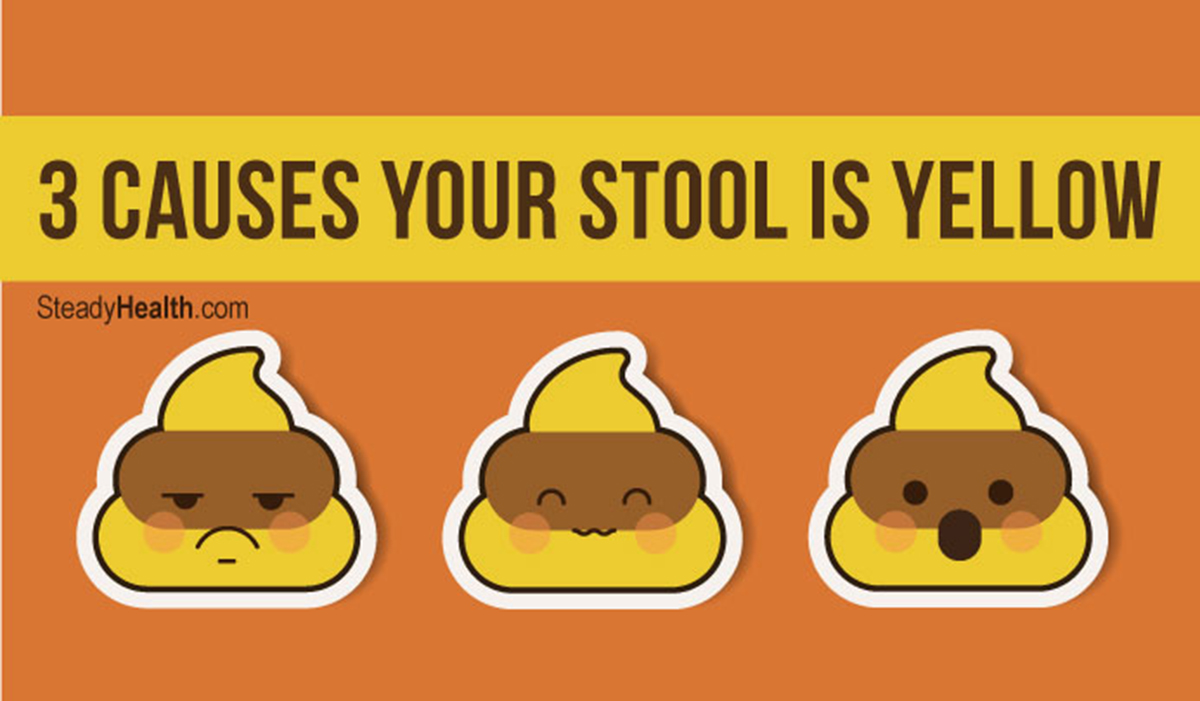As we progress through the potentially abnormal colors of stool, we have learned the causes of black stools can be from internal bleeding or from dietary habits, causes of gray stools can represent bile salt issues and that frequent bowel movements are possible with both of these medical conditions [1].
Another possible color of your bowel movements can be yellow. In most cases, yellow is a harder color for patients to identify in their bowel movements because normal stools have a brownish yellow tint. When the yellow color has a higher concentration, however, it can become more obvious.

Yellow bowel movements: Steatorrhea
When it comes to the human body, generally, bright yellow colors are associated with fats. Yellow is the color where most lipids will be and if you have ever had a deep superficial injury, you may have noticed yellow tissues under your skin, as well. Stool can also be yellow due to an abundance of fat that can lead to a yellow hue. In medicine, an abundance of fats is termed steatorrhea.
Many medical conditions can lead to the high levels of fat in our stools. Most of these syndromes have a common origin where malabsorption is occurring. If foods are rushed through the intestines too quickly, there will not be adequate time for the fats to properly digest and the result will be a higher concentration of fat in the final bowel specimens [3]. Some of the most likely causes of steatorrhea include diseases like Celiac disease, gallbladder stones and chronic pancreatitis [4].
Any damage along the biliary tract will result in impaired secretion of enzymes necessary to digest fat. If you do not have this occur, you will be unable to break down fats that our body cannot absorb without processing. A disease like Celiac disease can result in steatorrhea because of the high levels of inflammation present in the intestines that impair absorption.
Yellow stool caused by viral infections
Not only can disorders of the biliary system and intestines lead to yellow stool production, viral infections can also potentially cause this occurrence. A very common disease in society is rotavirus. You may not have heard of the name before, but just think of a time in your past where you experienced a bad stomach ache and had chronic diarrhea for about 24 to 48 hours. This kind of unpleasant stomach bug of short duration would most likely be caused by rotavirus. Rotavirus is more commonly seen in pediatric populations (children), but if you are an adult who spends a lot of time around children, this can increase your chances of contracting the disease.
Rotavirus is a disease that is linked with steatorrhea as well. In one study examining the stools of 25 patients suffering from a rotavirus infection, 14 of them had obvious signs of fat globules just on simple microscopic evaluation. Of these 14 cases, 11 of them were found to have rotavirus also present in the stools compared to only 2 cases with the rotavirus conclusively absent. [5]
The reason this infection can cause yellow bowel movements is due to the underlying mechanism of rotavirus. Because of the rapid spike in inflammation and the subsequent response of the immune system, the rotavirus is able to impede the digestion and absorption of fats as well as pigment all along the alimentary tract.
Because of the frequent bowel movements that you will also have with this disease, your intestines will not have enough time to absorb the fats that you are able to digest and the resulting stools will have high concentrations of viral particles. Other viruses are capable of causing this as well. However, rotavirus is extremely common and is most commonly linked to gastroenteritis.
Readers may be interested to learn that there have been reported cases in which COVID-19 led to yellow bowel movements and diarrhea, as well. In this case, you will also likely be experiencing respiratory symptoms and a fever.
Medications can cause yellow bowel movements, too
The last category that I will explore further would be the emerging market of weight loss medications as a cause of yellow stools. As the frequency of obesity increases in modern society, and at the same time, there is a social pressure to be thin, the prevalence of people turning to quick solutions like weight loss pills is increasing at an explosive rate.
With promises of losing 10 pounds within 10 days, it is no surprise that many people can turn to this type of "magic weight loss solution" compared to traditional dieting and exercise that may take months to achieve the same end goal.
It is believed that nearly 20 percent of the North American population currently use some type of medication that promises to aid weight loss, and nearly 60 percent fail to report taking it to their primary doctors [6]. This could be due to embarrassment because weight loss pills are sold as over-the-counter supplements.
One of the most popular drugs in commercials on the television and in stores would be Hydroxycut. This is a medication that can lead to quick weight loss by blocking the absorption of fat as well as increasing water waste. The ads claim that Hydroxycut is a safe product but further research indicates that there is a great risk of liver toxicity and malabsorption syndromes from taking this medication. Because it is an OTC medication, Hydroxycut does not have to meet the same safety regulations a medication with a prescription will require and patients continue falling victims to these types of treatments without fully understanding the risks they are taking. [7]
A final word
Because obviously yellow colored bowel movements most likely represent steatorrhea, which can itself have multiple causes, it is important for patients not to ignore this symptom, particularly if it presents over long periods of time. Please see your doctor for adequate diagnosis and possible treatment.
- Photo courtesy of SteadyHealth.com


Your thoughts on this